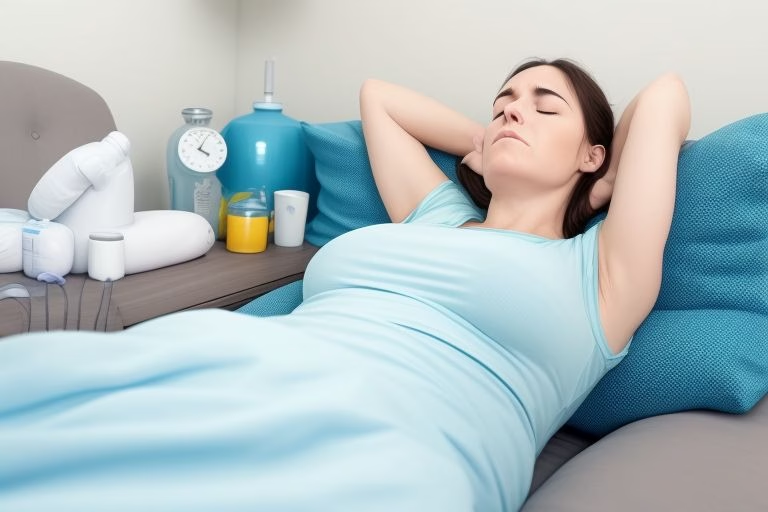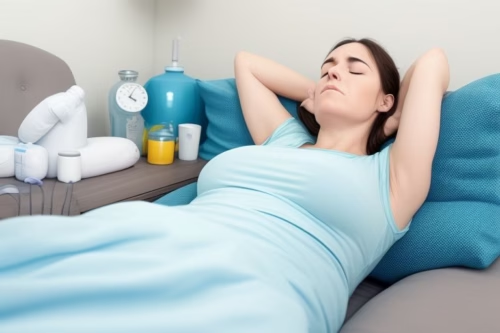
Living with dyspnea while lying down can feel overwhelming, but you are not alone. Millions of people worldwide experience breathing difficulties in various forms, and there are actionable steps you can take to reclaim comfort and improve your quality of life. This comprehensive guide will explore the causes, diagnosis, treatments, and lifestyle changes that can help you manage dyspnea while lying down. With empowering insights and practical advice, you can learn to breathe easier and live more fully.
What Is Dyspnea While Lying Down?
Dyspnea while lying down, also known as orthopnea, refers to the sensation of breathlessness that occurs when you are in a horizontal position. It is a common symptom in various medical conditions, including heart failure and lung disorders, where fluid redistribution or impaired respiratory function can trigger shortness of breath. Unlike general dyspnea that may occur during exertion, this specific type worsens when lying flat and often improves when sitting up or propping up with pillows.
For more in-depth information on what causes dyspnea while lying down, consider visiting the Mayo Clinic’s page on shortness of breath for additional insights.

Understanding the Causes
There are several underlying causes of dyspnea while lying down, each of which requires a nuanced approach to management. Below, we explore the most common factors that may contribute to this condition:
1. Heart Failure
One of the most significant causes of dyspnea while lying down is congestive heart failure. When the heart’s pumping efficiency is compromised, fluid can accumulate in the lungs, leading to breathing difficulties. Patients often report that they feel short of breath when they lie down due to the redistribution of fluid. Learn more about heart failure and its symptoms on WebMD.
2. Obesity
Excess weight can place additional pressure on the diaphragm and lungs, impairing normal respiratory function. This mechanical disadvantage may contribute to dyspnea while lying down. Weight management through diet and exercise is often recommended as part of the treatment plan.
3. Chronic Obstructive Pulmonary Disease (COPD)
Patients with COPD or other chronic lung diseases may experience dyspnea while lying down because of compromised lung function. COPD causes a narrowing of the airways and chronic inflammation, making it harder to breathe in any position, with lying down exacerbating the problem.
4. Asthma
Asthma can lead to episodes of dyspnea when the airways narrow, particularly at night. While not all asthma sufferers experience dyspnea while lying down, the combination of reduced airflow and nighttime triggers can be a challenge.
5. Anxiety and Panic Disorders
Psychological factors can also play a role. Stress and anxiety may heighten your awareness of your breathing, and in some cases, cause a feeling of dyspnea while lying down. Techniques such as mindfulness and deep breathing exercises can help alleviate these symptoms.
For more detailed medical explanations and treatment options, consider exploring articles on Healthline’s breathing difficulties section.
Recognizing the Symptoms
Understanding the symptoms associated with dyspnea while lying down is crucial for early intervention and effective management. Common symptoms include:
- Shortness of Breath: A feeling of not getting enough air, especially when in a horizontal position.
- Wheezing or Coughing: These may occur due to fluid accumulation or airway constriction.
- Chest Tightness: A sensation of pressure or discomfort in the chest, which can worsen when lying down.
- Rapid or Shallow Breathing: An increased respiratory rate may be noticeable.
- Fatigue: The constant struggle to breathe can lead to overall tiredness and a decrease in energy levels.
Recognizing these symptoms early is the first step toward seeking appropriate treatment. If you experience persistent dyspnea while lying down, consult your healthcare provider for a comprehensive evaluation.
How Is Dyspnea While Lying Down Diagnosed?
Diagnosing dyspnea while lying down requires a thorough evaluation of your medical history, a physical examination, and sometimes, specialized tests. Here’s what you can typically expect during the diagnostic process:
Medical History and Physical Examination
Your healthcare provider will begin by asking about your symptoms, lifestyle, and medical history. They will check for risk factors such as obesity, heart conditions, or a history of lung disease. A physical examination, including listening to your heart and lungs, is a crucial step.
Diagnostic Tests
Several tests may be conducted to pinpoint the cause of dyspnea while lying down:
- Chest X-ray: This can help detect abnormalities in the lungs or heart.
- Echocardiogram: This ultrasound of the heart is particularly useful if heart failure is suspected.
- Pulmonary Function Tests: These tests assess how well your lungs are working.
- Electrocardiogram (ECG): To check for any heart rhythm abnormalities.
- Blood Tests: These can help identify underlying conditions such as anemia or infection.
For further reading on diagnostic methods, the National Heart, Lung, and Blood Institute provides a detailed overview of diagnostic tests for heart-related breathing difficulties.
Treatment Options: Empowering You to Breathe Easier
Managing dyspnea while lying down involves a combination of medical treatments and lifestyle modifications. The treatment plan depends on the underlying cause and severity of the symptoms.
Medical Treatments
1. Medications
- Diuretics: Commonly used in heart failure to help reduce fluid build-up.
- Bronchodilators and Steroids: These are often prescribed for COPD or asthma to open airways and reduce inflammation.
- ACE Inhibitors and Beta Blockers: These medications can improve heart function and relieve symptoms in patients with heart failure.
For detailed medication information, check out the American Heart Association’s guidelines.
2. Oxygen Therapy
If your oxygen levels are low, your doctor may recommend supplemental oxygen therapy. This treatment helps ensure that your body receives enough oxygen, particularly during sleep.
3. Surgical Interventions
In severe cases, where medication and lifestyle changes do not provide sufficient relief, surgical interventions may be necessary. Procedures such as valve repair or replacement for heart issues, or lung surgery for chronic respiratory conditions, can be considered.
Lifestyle Modifications
1. Elevate Your Head While Sleeping
One of the simplest yet most effective ways to manage dyspnea while lying down is to elevate your head using extra pillows or an adjustable bed. This position reduces the gravitational pull of fluid towards the lungs, thereby alleviating shortness of breath.
2. Weight Management
Maintaining a healthy weight can significantly reduce the burden on your respiratory and cardiovascular systems. A balanced diet and regular physical activity are key to managing dyspnea while lying down caused by obesity.
3. Regular Exercise
Engaging in regular, moderate exercise can improve cardiovascular health and lung capacity. Even light activities such as walking or yoga can help enhance overall respiratory function. Always consult your healthcare provider before starting any new exercise regimen.
4. Quit Smoking
Smoking is one of the leading causes of lung diseases like COPD. Quitting smoking is crucial if you suffer from dyspnea while lying down, as it can greatly improve lung function and overall health. For support on quitting smoking, visit the American Lung Association’s quit smoking page.
5. Stress Management
Techniques such as deep breathing exercises, meditation, and mindfulness can reduce anxiety and improve your overall sense of well-being. Managing stress is an important part of reducing the sensation of dyspnea while lying down when anxiety is a contributing factor.
Natural and Home Remedies
In addition to medical treatment and lifestyle changes, there are several home remedies and natural approaches that can help manage dyspnea while lying down:
1. Herbal Teas and Natural Anti-Inflammatories
Herbal teas, such as ginger or peppermint tea, may help soothe the respiratory system and reduce inflammation. While these remedies are not a replacement for medical treatment, they can be a beneficial complementary approach.
2. Breathing Exercises
Practicing breathing exercises can strengthen your respiratory muscles and improve lung capacity. Techniques like diaphragmatic breathing and pursed-lip breathing can be particularly effective. For a comprehensive guide on breathing exercises, check out Healthline’s breathing exercises article.
3. Aromatherapy
Essential oils such as eucalyptus and lavender may help open the airways and promote relaxation. Using a diffuser or inhaling these essential oils can provide symptomatic relief for dyspnea while lying down.
4. Sleep Position Adjustments
Experiment with different sleep positions. In addition to elevating your head, sleeping on your side instead of your back may reduce the sensation of dyspnea while lying down. A propped-up position can ease the work your lungs have to do during sleep.
The Importance of a Multidisciplinary Approach
Managing dyspnea while lying down often requires a team approach. Your healthcare team may include:
- Primary Care Physicians: Overseeing your overall health.
- Cardiologists: For heart-related causes.
- Pulmonologists: Specialists in respiratory disorders.
- Nutritionists: To help with weight management and a balanced diet.
- Physical Therapists: To develop a safe and effective exercise program.
A collaborative approach ensures that every aspect of your health is addressed, leading to more effective management of dyspnea while lying down.
Living Positively with Dyspnea While Lying Down
A diagnosis of dyspnea while lying down can be daunting, but many people lead full, active lives with the proper management strategies. Here are some tips for maintaining a positive mindset:
1. Stay Informed
Knowledge is power. Educate yourself about your condition by reading reputable sources and staying in touch with your healthcare provider. Outbound links like those provided by Mayo Clinic and American Heart Association can be invaluable.
2. Build a Support Network
Join support groups or online communities where you can share experiences and advice with others facing similar challenges. Emotional support is critical in managing any chronic health condition.
3. Set Realistic Goals
Focus on small, achievable changes that can lead to significant improvements over time. Whether it’s gradually increasing your daily walk or mastering a new breathing technique, every step counts.
4. Celebrate Progress
Keep a journal to track your progress and celebrate small victories. Recognizing improvements in your breathing and overall health can boost your motivation to continue making positive changes.
5. Practice Mindfulness
Incorporate mindfulness and stress-reduction techniques into your daily routine. Mindfulness meditation has been shown to improve respiratory function and reduce the perception of dyspnea by calming the mind and body.
For additional strategies on maintaining a positive outlook while managing chronic conditions, the National Institute of Mental Health offers valuable resources.
Frequently Asked Questions
Q1: What exactly is the difference between orthopnea and dyspnea while lying down?
Orthopnea is a specific term used to describe dyspnea while lying down, particularly as it relates to conditions like heart failure. Both terms refer to shortness of breath that worsens in a horizontal position.
Q2: Can lifestyle changes alone manage dyspnea while lying down?
In some cases, especially when dyspnea while lying down is caused by factors like obesity or anxiety, lifestyle changes can make a significant difference. However, when the underlying cause is a serious condition such as heart failure or COPD, medical intervention is essential.
Q3: What should I do if I experience sudden or severe dyspnea while lying down?
If you experience sudden, severe shortness of breath or other concerning symptoms, seek emergency medical attention immediately. It is always better to be safe and get a professional evaluation if your condition worsens.
Tips to Prevent Dyspnea While Lying Down
Prevention is always better than cure. Here are some proactive steps you can take:
- Regular Health Check-ups: Early detection of conditions like heart failure and COPD can prevent the progression of dyspnea while lying down.
- Maintain a Healthy Lifestyle: A balanced diet, regular exercise, and weight management are your best defenses against many causes of breathing difficulties.
- Manage Stress: Practice regular stress-relief activities such as yoga, meditation, or simply engaging in hobbies you love.
- Monitor Your Environment: Ensure that your living environment is free from allergens and pollutants that could exacerbate respiratory issues.
- Stay Hydrated: Proper hydration supports overall health, including the respiratory system.
For additional prevention tips, the Centers for Disease Control and Prevention (CDC) offers reliable health information.
Final Thoughts
Dyspnea while lying down does not have to define your life. With the right blend of medical care, lifestyle modifications, and natural remedies, you can significantly improve your breathing and overall quality of life. Remember, every positive change, no matter how small, can lead to better health outcomes. Empower yourself with knowledge, surround yourself with supportive professionals and loved ones, and take charge of your respiratory health.
Breathing is a fundamental part of living. By understanding the causes and treatment options for dyspnea while lying down, you can move towards a future where breathing is easy, and every night’s sleep is restful and rejuvenating. Keep this guide as a reference and a reminder that improvement is possible—step by step, breath by breath.
Additional Resources and Outbound Links
- Mayo Clinic – Shortness of Breath
- WebMD – Heart Failure: Symptoms, Signs, and Causes
- Healthline – Breathing Exercises
- American Heart Association – Treatment Options for Heart Failure
- National Heart, Lung, and Blood Institute – Diagnosing Heart Failure
- American Lung Association – Quit Smoking
- Centers for Disease Control and Prevention (CDC)
- National Institute of Mental Health
Conclusion
Overcoming dyspnea while lying down is not an insurmountable challenge. With a proactive approach that includes lifestyle modifications, medical treatments, and a supportive network, you can experience a noticeable improvement in your quality of life. Empower yourself with the knowledge shared in this guide, and take the necessary steps towards a healthier, happier life where every breath feels easier. Start your journey today, and remember: every small change makes a big difference when it comes to breathing easy and living well.
By integrating these strategies and utilizing the resources provided, you’re on the path to not only managing dyspnea while lying down but potentially overcoming it altogether. Let this guide be your companion in making informed decisions that enhance your respiratory health, promote a positive mindset, and inspire you to take charge of your well-being.
Stay informed, stay empowered, and breathe easy!
Note: This article is for informational purposes only and does not substitute professional medical advice. If you experience severe symptoms or have concerns about your health, please consult a healthcare professional immediately.



